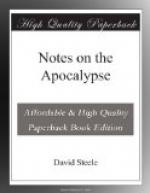7. And he came and took the book out of the right hand of him that sat upon the throne.
V. 7.—The Lord Jesus approaches his Father’s throne to receive the roll. And with the prophet we may ask,—“Who is this that engaged his heart to approach?” (Jer. xxx. 21.)—With all who are honored to surround the throne, we may joyfully answer in the words of the Psalmist,—It is the “Lord, strong and mighty in battle.” (Ps. xxiv. 8.) “He took the book.”—This action symbolically signified the authoritative commission given by the Father and received by the Mediator to proceed in the execution of the divine decree, and in discharge of his threefold office as prophet, priest and king,—especially and more formally his prophetical and kingly offices.
8. And when he had taken the book, the four beasts and four and twenty elders fell down before the Lamb, having every one of them harps, and golden vials full of odours, which are the prayers of saints.
V. 8.—No sooner does the “Lamb take the book,” than all spectators are apprized of the act, and instantly give expression to their confidence and joy. Among all the worshippers before the throne, the “four animals” take precedence, and lead by their own example as before, (ch. iv. 9.) They gave “glory” etc., to God creator, as in the person of the Father; and now in the presence of the Father’s manifested glory, they prostrate themselves before the “Lamb,” in obedience to the Father’s command, “That all men should honor the Son, even as they honor the Father.” (John v. 23.)—The “four and twenty elders,”—the representatives of all the children of God, cordially join the ministry in these acts of solemn worship. Some of the furniture employed in the temple worship, is here introduced, to harmonize with the rest of the symbolic scenery. “Harps and golden vials” signify praise and prayer. Our modern advocates for instrumental music in God’s worship, to be consistent, must associate with the “harps,” the “incense-cups” and the “golden altar:” for all belonged alike to the service of the temple. Even in the time when such “vessels of the ministry” were in use with divine approbation, the Psalmist had greater clearness,—more evangelical conceptions of the temporary use of those “beggarly elements whereunto many desire again to be in bondage” than they seem to have. (Gal. iv. 9.) He knew, even then, that “incense and the evening sacrifice” represented spiritual worship. (Ps. cxli. 2.) Others there are, who question whether Christ as Mediator be the formal object of worship? While they acknowledge his supreme deity as God equal with the Father, they are in doubt on his assuming human nature, whether, “as such, he is the object of worship!” Such doubts are groundless, as unanswerably shown in this place, and in many others, such as John xx. 28: xxi. 17; Ps. xlv. 11; xcvii. 7; Heb. i. 6. All these worshippers appear to know that the nature of the altar at which they worship determines the kind of oblations to be offered: namely,—“spiritual sacrifices, acceptable to God by Jesus Christ.” (1 Pet. ii. 5.)




